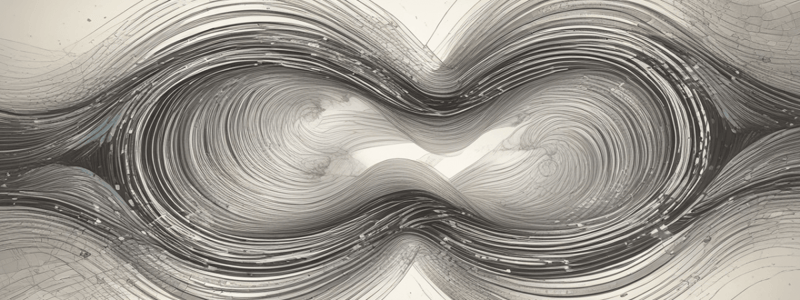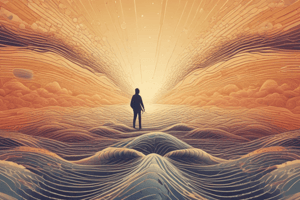Podcast
Questions and Answers
Flashcards are hidden until you start studying
Study Notes
Wave-Particle Duality Overview
- Wave-particle duality refers to the dual nature of light, which can be described as both a particle and a wave.
- This concept is central to quantum physics, applying not only to light but to all particles or quanta.
Historical Context
- The debate over light's nature began in the 17th century, notably between Isaac Newton (particle theory) and Christiaan Huygens (wave theory).
- Thomas Young's Double Slit Experiment in the early 19th century showed wave behavior of light through diffraction patterns.
- Albert Einstein's work on the photoelectric effect in 1921 contributed further evidence for light's particle nature, leading to the concept of photons.
Light as a Wave
- Waves are characterized by disturbances that propagate energy; they display properties like wavelength and frequency.
- Light has oscillatory behavior; it can reflect and refract, highlighting wave-like characteristics.
- Evidence of wave behavior includes diffraction, as demonstrated by Young's experiment where light produced an interference pattern through slits.
Evidence of Light as a Particle
- Newton noted that light travels in straight lines and through a vacuum, supporting particle theory.
- The photoelectric effect demonstrated that light can eject electrons from metal, giving rise to particle-like behavior.
- Key observations included:
- Immediate electron ejection upon light exposure, contrary to wave theory predictions.
- The dependence of electron energy on the wavelength of light rather than intensity.
Quantum Explanation of Light
- Light was quantized into discrete packets called photons, introduced by Max Planck and later utilized by Einstein.
- The energy of a photon is directly proportional to its wavelength; shorter wavelengths correspond to higher energy.
Wave-Particle Duality of Matter
- Louis de Broglie proposed in 1923 that particles with mass also exhibit wave properties, predicted for electrons using a similar setup as the Double Slit Experiment.
- The experiment by Clinton Davisson, Lester Germer, and George Paget Thomson in 1927 confirmed de Broglie's hypothesis of electron diffraction.
- De Broglie was awarded the Nobel Prize in 1929 for this groundbreaking theory, expanding wave-particle duality beyond light to matter.
Modern Implications
- Wave-particle duality challenges classical physics and traditional intuitions, emphasizing a complex understanding of the microscopic world.
- Subsequent research has shown that even larger objects, such as molecules, can exhibit wave properties, although testing becomes increasingly difficult as size increases.
Wave-Particle Duality Overview
- Wave-particle duality refers to the dual nature of light, which can be described as both a particle and a wave.
- This concept is central to quantum physics, applying not only to light but to all particles or quanta.
Historical Context
- The debate over light's nature began in the 17th century, notably between Isaac Newton (particle theory) and Christiaan Huygens (wave theory).
- Thomas Young's Double Slit Experiment in the early 19th century showed wave behavior of light through diffraction patterns.
- Albert Einstein's work on the photoelectric effect in 1921 contributed further evidence for light's particle nature, leading to the concept of photons.
Light as a Wave
- Waves are characterized by disturbances that propagate energy; they display properties like wavelength and frequency.
- Light has oscillatory behavior; it can reflect and refract, highlighting wave-like characteristics.
- Evidence of wave behavior includes diffraction, as demonstrated by Young's experiment where light produced an interference pattern through slits.
Evidence of Light as a Particle
- Newton noted that light travels in straight lines and through a vacuum, supporting particle theory.
- The photoelectric effect demonstrated that light can eject electrons from metal, giving rise to particle-like behavior.
- Key observations included:
- Immediate electron ejection upon light exposure, contrary to wave theory predictions.
- The dependence of electron energy on the wavelength of light rather than intensity.
Quantum Explanation of Light
- Light was quantized into discrete packets called photons, introduced by Max Planck and later utilized by Einstein.
- The energy of a photon is directly proportional to its wavelength; shorter wavelengths correspond to higher energy.
Wave-Particle Duality of Matter
- Louis de Broglie proposed in 1923 that particles with mass also exhibit wave properties, predicted for electrons using a similar setup as the Double Slit Experiment.
- The experiment by Clinton Davisson, Lester Germer, and George Paget Thomson in 1927 confirmed de Broglie's hypothesis of electron diffraction.
- De Broglie was awarded the Nobel Prize in 1929 for this groundbreaking theory, expanding wave-particle duality beyond light to matter.
Modern Implications
- Wave-particle duality challenges classical physics and traditional intuitions, emphasizing a complex understanding of the microscopic world.
- Subsequent research has shown that even larger objects, such as molecules, can exhibit wave properties, although testing becomes increasingly difficult as size increases.
Wave-Particle Duality Overview
- Wave-particle duality refers to the dual nature of light, which can be described as both a particle and a wave.
- This concept is central to quantum physics, applying not only to light but to all particles or quanta.
Historical Context
- The debate over light's nature began in the 17th century, notably between Isaac Newton (particle theory) and Christiaan Huygens (wave theory).
- Thomas Young's Double Slit Experiment in the early 19th century showed wave behavior of light through diffraction patterns.
- Albert Einstein's work on the photoelectric effect in 1921 contributed further evidence for light's particle nature, leading to the concept of photons.
Light as a Wave
- Waves are characterized by disturbances that propagate energy; they display properties like wavelength and frequency.
- Light has oscillatory behavior; it can reflect and refract, highlighting wave-like characteristics.
- Evidence of wave behavior includes diffraction, as demonstrated by Young's experiment where light produced an interference pattern through slits.
Evidence of Light as a Particle
- Newton noted that light travels in straight lines and through a vacuum, supporting particle theory.
- The photoelectric effect demonstrated that light can eject electrons from metal, giving rise to particle-like behavior.
- Key observations included:
- Immediate electron ejection upon light exposure, contrary to wave theory predictions.
- The dependence of electron energy on the wavelength of light rather than intensity.
Quantum Explanation of Light
- Light was quantized into discrete packets called photons, introduced by Max Planck and later utilized by Einstein.
- The energy of a photon is directly proportional to its wavelength; shorter wavelengths correspond to higher energy.
Wave-Particle Duality of Matter
- Louis de Broglie proposed in 1923 that particles with mass also exhibit wave properties, predicted for electrons using a similar setup as the Double Slit Experiment.
- The experiment by Clinton Davisson, Lester Germer, and George Paget Thomson in 1927 confirmed de Broglie's hypothesis of electron diffraction.
- De Broglie was awarded the Nobel Prize in 1929 for this groundbreaking theory, expanding wave-particle duality beyond light to matter.
Modern Implications
- Wave-particle duality challenges classical physics and traditional intuitions, emphasizing a complex understanding of the microscopic world.
- Subsequent research has shown that even larger objects, such as molecules, can exhibit wave properties, although testing becomes increasingly difficult as size increases.
Studying That Suits You
Use AI to generate personalized quizzes and flashcards to suit your learning preferences.




